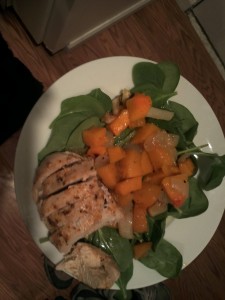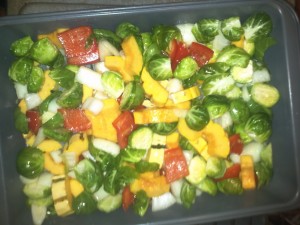However, I’m happy to share a few tips I use when creating meal plans. With this info you should have no problem creating your own monthly meal plans. I’m going to keep this specific to dinner, because that is the meal most folks as me about. It is also the meal you want to plan most strategically if you’re looking to keep your waistline in check. What you eat for dinner is what you take to bed. Remember that!
1. Designate your protein source. This is the cornerstone of your meal. Having a good protein source at dinner will help fill you up and keep you feeling satisfied for the rest of the evening – keeping snacking at bay and curbing cravings for sweets. You have many options here: chicken breast, turkey, ground poultry (turkey or chicken), wild salmon, lean red meats (lean ground beef, bison, lean beef cuts), eggs (yes, even for dinner), lentils, black beans, garbanzo beans, tofu (I don’t recommend much soy, and always keep it organic/non-GMO).
I try to pre cook protein sources whenever possible. Bake a bunch of chicken breasts on Sunday and use them all week – as a main dish, chopped in salads, mixed in stir fry. I recently started doing the same with turkey burgers. Make a bunch of burgers and use them throughout the week – as burgers or added to other dishes (crumbled or whole.) Whenever you prepare a protein, try to make extra that can be saved for another quickie meal. You will always be glad you did this!
2. Designate your veggies. Veggies can be their own side dish or they can be mixed into your main meal. Or better yet – both! Green bean french fries are always a hit with the kids. Many veggies are great simply sauteed in some olive oil, garlic and sea salt (broccoli, snap peas, green beans, asparagus, cauliflower). Sauteeing greens (spinach, kale, chard, beet greens) is a great way to get in a lot of veggie volume easily. Again, saute in oil (olive or coconut) with sea salt and garlic. Curly kale really holds flavor, so jazz it up any way you like! I’ll frequently add a splash of low sodium chicken broth and red pepper flakes.
Another really family friendly veggie option is a big veggie roast. This allows the kids to pick out the veggies they like and you can load up on a bunch of your faves too.You can also make your veggie into you savory carbs – think cauliflower mash, spaghetti squash, roasted butternut, acorn or delicata squash. These are all excellent with just a bit of oil, sea salt and some crumbled cheese of your choice (I love goat). I usually add pistachios too. I have a thing for pistachios, goat cheese and squash. Not idea where I got it – but YUM!
Of course, salad is another options here. There are endless options with salad and it’s a great way to get in a lot of veggie variety. I recommend cutting up a bunch of salad fixings early in the week, so you can just toss handfuls of veggies over some mixed greens or spinach every night. Splash with your fave dressing (I use just a sprinkle of olive oil and a splash of balsamic). Add some nuts and a bit of crumbled cheese (feta, goat, blue) and any veggie combo will be delish!
3. Designate your carbs – maybe. At dinner you really don’t *need* a major source of carbs. If you have your protein and a few sources of veggies, that is all you need for evening fuel. However, many people are conditioned to wanting some comfort carbs with dinner. A great way to feel like you’re getting your comfort food without loading your belly full of carbs that will just turn to extra unusable sugar as you sleep is to get your starch from your veggies. For this you can use any sort of squash, as mentioned above, or yams. These are all low glycemic carb sources that are much more appropriate for dinner than breads, pastas, rice etc.
Another way to get your carb fix at dinner is to change up your grains. Instead of pasta or rice try quinoa, barley or wheatberries. These grains are 100% unrefined whole grains (or seeds, in the case of quinoa) that are much higher in fiber and protein than processed white grains. They give you that comfort feeling you get from carbs without jacking up your blood sugar before bed. Because of the protein and fiber content, they will fill you up, too. You won’t need a large quantity, like that endless bowl of pasta that never makes you quite full enough.
I use grains of any sort very sparingly in the evening. For example, in a stir fry, I’ll use tons of veggies, some sort of protein and broccoli slaw (my “noodles”). If I want to bulk it up some more, I’ll add a quinoa/barley blend, just to give it a bit of that comfort food feel. Because it is so full of other goodness, I don’t need much of the grains. And because of my choice of grains, I don’t need to worry about a bunch of sugar sitting in my gut as extra calories when I go to bed.
These are the three biggest things I consider when I plan each meal for my programs. From there is is just a lot of mixing and matching. If this is a struggle for you, I highly recommend following one of our meal plans. 80% of your success in changing your body is going to come from changing your diet. So lean on solid resources as much as you need to as you make these changes. Taking the burden off yourself and following a plan can make a tremendous difference in actually seeing results.
Remember, you can get any of our programs for 30-40% off until tomorrow!
Comments
Powered by Facebook Comments



